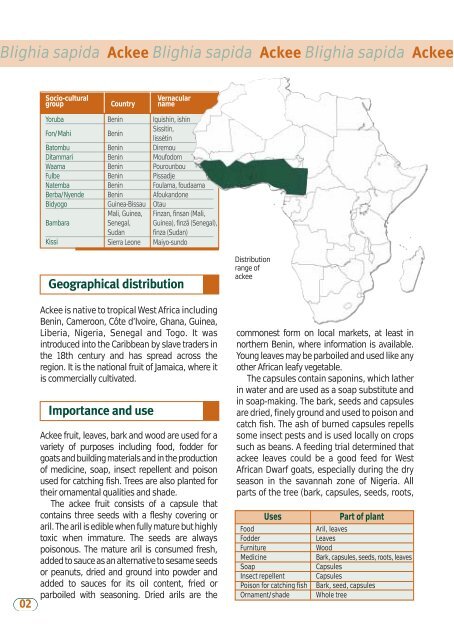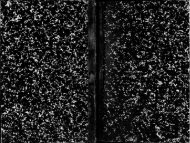Blighia sapida Ackee Blighia sapida Ackee Blighia sapida Ackee
Blighia sapida Ackee Blighia sapida Ackee Blighia sapida Ackee
Blighia sapida Ackee Blighia sapida Ackee Blighia sapida Ackee
You also want an ePaper? Increase the reach of your titles
YUMPU automatically turns print PDFs into web optimized ePapers that Google loves.
<strong>Blighia</strong> <strong>sapida</strong> <strong>Ackee</strong> <strong>Blighia</strong> <strong>sapida</strong> <strong>Ackee</strong> <strong>Blighia</strong> <strong>sapida</strong> <strong>Ackee</strong><br />
02<br />
Socio-cultural Vernacular<br />
group Country name<br />
Yoruba<br />
Fon/Mahi<br />
Batombu<br />
Ditammari<br />
Waama<br />
Fulbe<br />
Natemba<br />
Berba/Nyende<br />
Bidyogo<br />
Bambara<br />
Kissi<br />
Benin<br />
Benin<br />
Benin<br />
Benin<br />
Benin<br />
Benin<br />
Benin<br />
Benin<br />
Guinea-Bissau<br />
Mali, Guinea,<br />
Senegal,<br />
Sudan<br />
Sierra Leone<br />
Geographical distribution<br />
Iguishin, ishin<br />
Sissitin,<br />
lissètin<br />
Diremou<br />
Moufodom<br />
Pourounbou<br />
Pissadje<br />
Foulama, foudaama<br />
Afoukandone<br />
Otau<br />
Finzan, finsan (Mali,<br />
Guinea), finzã (Senegal),<br />
finza (Sudan)<br />
Maiyo-sundo<br />
<strong>Ackee</strong> is native to tropical West Africa including<br />
Benin, Cameroon, Côte d’Ivoire, Ghana, Guinea,<br />
Liberia, Nigeria, Senegal and Togo. It was<br />
introduced into the Caribbean by slave traders in<br />
the 18th century and has spread across the<br />
region. It is the national fruit of Jamaica, where it<br />
is commercially cultivated.<br />
Importance and use<br />
<strong>Ackee</strong> fruit, leaves, bark and wood are used for a<br />
variety of purposes including food, fodder for<br />
goats and building materials and in the production<br />
of medicine, soap, insect repellent and poison<br />
used for catching fish. Trees are also planted for<br />
their ornamental qualities and shade.<br />
The ackee fruit consists of a capsule that<br />
contains three seeds with a fleshy covering or<br />
aril. The aril is edible when fully mature but highly<br />
toxic when immature. The seeds are always<br />
poisonous. The mature aril is consumed fresh,<br />
added to sauce as an alternative to sesame seeds<br />
or peanuts, dried and ground into powder and<br />
added to sauces for its oil content, fried or<br />
parboiled with seasoning. Dried arils are the<br />
Distribution<br />
range of<br />
ackee<br />
commonest form on local markets, at least in<br />
northern Benin, where information is available.<br />
Young leaves may be parboiled and used like any<br />
other African leafy vegetable.<br />
The capsules contain saponins, which lather<br />
in water and are used as a soap substitute and<br />
in soap-making. The bark, seeds and capsules<br />
are dried, finely ground and used to poison and<br />
catch fish. The ash of burned capsules repells<br />
some insect pests and is used locally on crops<br />
such as beans. A feeding trial determined that<br />
ackee leaves could be a good feed for West<br />
African Dwarf goats, especially during the dry<br />
season in the savannah zone of Nigeria. All<br />
parts of the tree (bark, capsules, seeds, roots,<br />
Uses<br />
Food<br />
Fodder<br />
Furniture<br />
Medicine<br />
Soap<br />
Insect repellent<br />
Poison for catching fish<br />
Ornament/shade<br />
Part of plant<br />
Aril, leaves<br />
Leaves<br />
Wood<br />
Bark, capsules, seeds, roots, leaves<br />
Capsules<br />
Capsules<br />
Bark, seed, capsules<br />
Whole tree
















